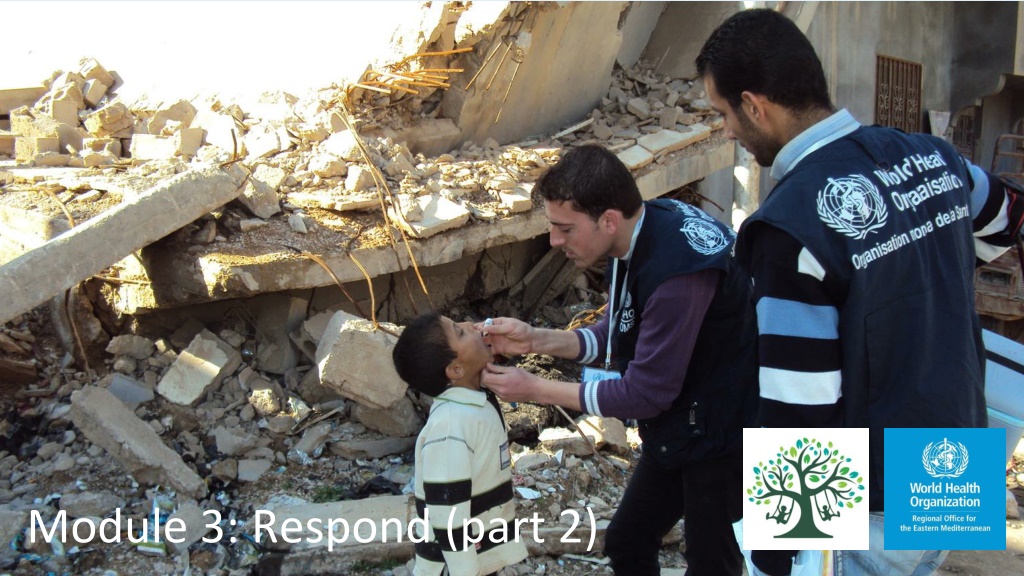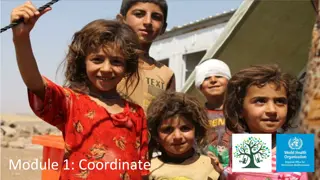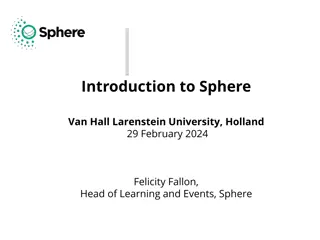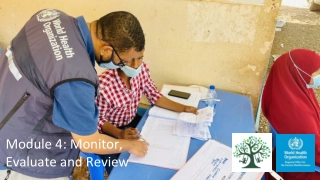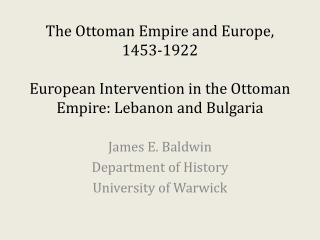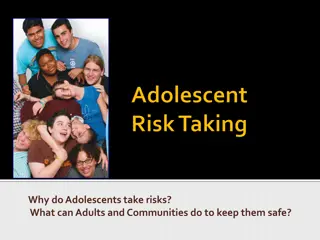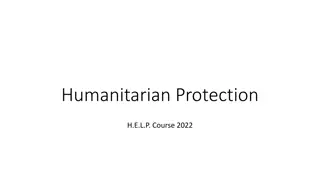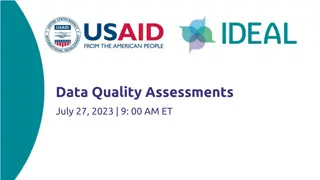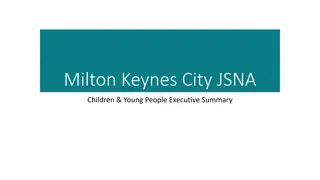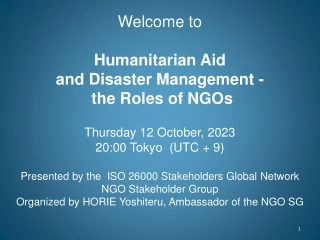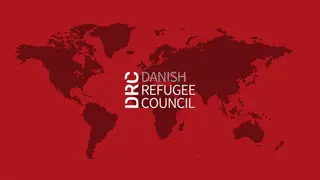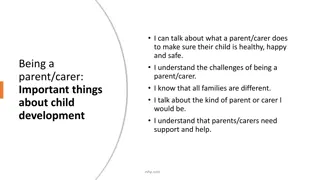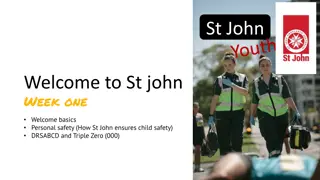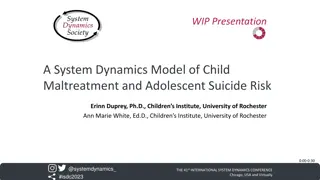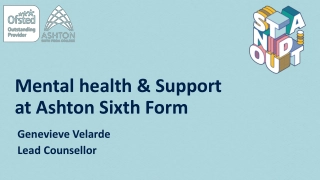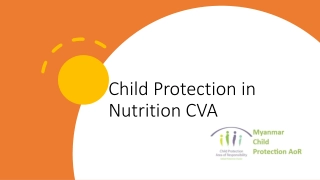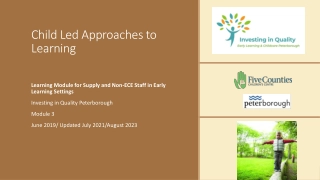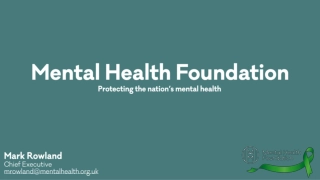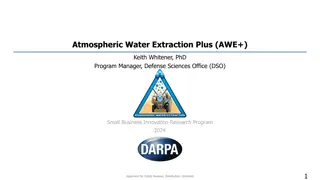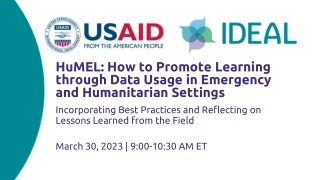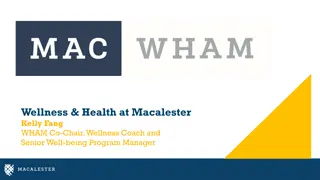Child and Adolescent Health in Humanitarian Settings: Operational Guide
This operational guide focuses on four interconnected programmatic action areas - Assess & Prioritise, Coordinate, Respond, and Monitor, Evaluate & Review. It provides guidance on obtaining data, coordinating approaches, planning and enacting activities, and using data systems to improve child and adolescent health-related activities in humanitarian emergencies. Key areas include deciding on an essential services package, identifying important fields such as child development and education, and emphasizing nurturing care for child development.
Download Presentation
Please find below an Image/Link to download the presentation.
The content on the website is provided AS IS for your information and personal use only. It may not be sold, licensed, or shared on other websites without obtaining consent from the author. Download presentation by click this link. If you encounter any issues during the download, it is possible that the publisher has removed the file from their server.
Presentation Transcript
Child and adolescent health in humanitarian settings: operational guide 2
The four interconnected programmatic action areas of the operational guide ASSESS & PRIORITISE How to obtain data on child/adolescent health (via needs assessment) and use it to prioritize actions COORDINATE How to take a coordinated approach to child and adolescent health in a humanitarian emergency RESPOND How to plan and enact a coordinated set of activities addressing the identified child and adolescent health priorities MONITOR, EVALUATE & REVIEW How to use data systems to review and improve child and adolescent health- related activities 3
Respond 5
Important CAH fields for an essential service package 2.1 Acute conditions (general) 2.2 Chronic conditions (general) 2.3 Child safety and protection 2.4 Disease outbreaks and immunization 2.5 Nutrition and food security 2.6 Child development and education 2.7 Disability 2.8 Psychosocial distress and mental health 2.9 Sexual and reproductive health 2.10 WASH 7
2.6 Child development and education Nurturing care is essential for child development Early childhood development (ECD) should be integrated into all humanitarian activities Children in conflict face compounded risks to their development due to experiences like displacement, migration, and resettlement, which may include integration into new settings like refugee camps or host communities. This could cause toxic stress that affects child development in general. Scan the QR code to do a puzzle based on this image 8
Nurturing care components Good health of children and caregivers Nurturing care: refers to the conditions needed by children to reach their full potential - keeping children safe, healthy and well nourished, paying attention and responding to their needs and interests, encouraging them to explore their environment and interact with caregivers and others. Adequate nutrition maternal and child Safety and security children and their families Opportunities for early learning Responsive caregiving
Education and early childhood development Education is vital during emergencies, sustaining communities Crucial for development and well-being Provides physical, psychosocial, and cognitive protection Enables early identification of at-risk children and those with additional needs Shields children from dangers like exploitation, early marriage, and involvement in crime Equips children with problem-solving and critical-thinking skills Educational venues serve as hubs for delivering essential support (food, WASH education, health services) Promotes inclusion and equality through equitable access for high-risk groups 10
Nurturing care for children living in humanitarian settings recommendations 1. Ensure responsive care for infants and children in the first 3 years 2. Encourage early learning activities with parents and caregivers during the first 3 years 3. Integrate support for responsive care and early learning into nutrition interventions for infants and young children 4. Integrate psychosocial interventions for maternal mental health into early childhood health and development services Actions can be tailored to different phases of emergencies, adjusting interventions based on contextual factors such as duration and type of humanitarian or security issues 11
Key actions Child development and education Integrate nurturing care in humanitarian action - The RMNCAH/CAH working group collaborates with education and other sectors to integrate nurturing care for all children in humanitarian action (refer to annex 5 and 6) - Share health promotion messages and information For more details, please refer to the operational guide 12
Key indicator Child development and education The RMNCAH/CAH working group and lead education cluster agency have regular meetings to strengthen coordination of activities 13
2.7 Disability Disability is an umbrella term covering impairments, activity limitations, and participation restrictions During crises, people with disabilities are more likely to be left behind, abandoned or neglected Disasters and armed conflict increase the number of children and adolescents with disabilities, to increase resilience this should be considered in humanitarian preparedness Often overlooked, resulting in inaccessible and inappropriate services Humanitarian agencies must ensure inclusive and appropriate actions for children and adolescents with disabilities 14
Children and adolescents with disabilities Disability inclusion is crucial across all stages of humanitarian planning, delivery, and evaluation Heightened risks when their coping mechanisms and support systems are compromised Challenges include the loss of assistive devices, medications, and social supports, increasing dependency on caregivers Accessibility issues, social stigma, and negative attitudes can prevent access to mainstream humanitarian services and food distribution Particularly vulnerable to abuse and neglect Consider the role of caregivers with disabilities so they can respond to the needs of their children 15
Key actions Disability Promote disability inclusion - RMNCAH/CAH working group and partners promote disability-inclusive approaches in all activities (Annex 7) Include children, adolescents, and families with disabilities in planning - Promote independence and self-management Ensure assistive devices are available for children and adolescents with mobility or communication issues Challenge discriminatory attitudes and promote equity For more details, please refer to the operational guide 16
Key indicator Disability All health care providers and partner agencies have adopted policies on disability-inclusive action, and are translating these into concrete actions 17
2.8 Psychosocial distress and mental health in humanitarian settings Humanitarian emergencies expose children and adolescents to psychosocial traumas such as displacement, food insecurity, and armed violence Emergencies weaken familial and community supports, escalating the risks of psychosocial issues and exacerbating pre-existing problems Children of all ages may express distress through developmental regression, anxiety, sleep problems, and changes in behavior both in and out of school 18
Psychosocial distress and mental health in humanitarian settings Substance abuse is a significant concern, especially for individuals in the armed forces Many young people face considerable loss and require support for grief and bereavement Humanitarian emergencies can unmask, trigger or exacerbate serious mental health problems (depression, anxiety, or post-traumatic stress disorder) 19
Key actions Psychosocial distress and mental health Promote good mental health and wellbeing - By the RMNCAH/CAH working group and partners work with child protection, education and other sectors Ensure availability of basic clinical mental health care - For priority conditions (including depression, anxiety, post-traumatic stress disorder) at every health facility Protect the rights of people with severe mental health problems - In the community, hospitals and institutions (e.g. schools and the workplace) Strengthen pre-existing community networks for psychosocial support to children and adolescents - Focusing on community networks can provide valuable support to the most vulnerable groups, helping them cope with stress and build resilience For more details, please refer to the operational guide 20
Key indicator Psychosocial distress and mental health The RMNCAH/CAH working group and partners have identified mental health priorities for children, adolescents, and their carers and families, in collaboration with the health cluster Basic mental health services are available at every facility 21
2.9 Sexual and reproductive health Sexual and reproductive health affects children of all ages Adolescents require culturally sensitive information for safeguarding their sexual and reproductive health Children and adolescents face risks of sexual exploitation, violence, and forced marriage, requiring adolescent-friendly support Pregnant adolescents are of greater risk for complications during pregnancy and childbirth 22
Sexually transmitted infections and unsafe abortions 50% new HIV infections occur in people aged 15 24 years, and 1/3th of new cases of curable STIs affect people <25 years Annually, 5 million adolescents (15-18 years) have unsafe abortions, causing 70 000 abortion- related deaths 23
Children and adolescents increased risks during crisis Unmet need for contraception and unwanted pregnancy HIV/AIDS and other sexually transmitted infections Early pregnancy Difficulties with the management of menstrual hygiene Sexual and gender- based violence (in all forms) Unsafe abortion 24
Key actions Sexual and reproductive health (1/2) Promoting adolescent health - Collaborate across clusters to establish education and referral services - Source and procure contraceptive supplies, ensuring availability - Train community workers for community-based family planning services Addressing gender-based violence - Coordinate health sector efforts against sexual violence - Provide comprehensive care for survivors - Raise community awareness about gender-based violence For more details, please refer to the operational guide 25
Key actions Sexual and reproductive health (2/2) Enhancing maternal and newborn care for adolescents - Establish a 24/7 referral system for obstetric emergencies - Provide adolescent-friendly maternal and newborn care - Coordinate identification of pregnant adolescents in communities among clusters Preventing STIs in adolescents - Provide discreet access to free condoms at adolescent-oriented points - Establish comprehensive prevention and treatment services for STIs - Offer care, support, and treatment for people living with HIV For more details, please refer to the operational guide 26
Key indicators Sexual and reproductive health The RMNCAH/CAH working group and partners have developed and communicated a plan to address sexual and reproductive health issues across the lifespan Gender-based violence programmes have been established, and referral pathways for children and adolescents are available and appropriate All services, including obstetric and maternity services, are adolescent friendly 27
2.10 WASH Faecal-oral diseases may contribute to over 40% of deaths in the acute phase of an emergency Overcrowded WASH facilities can be a considerable threat to children s safety WASH implementation may enable children and adolescents, especially girls, to attend school When designing refugee shelter and WASH facilities, ensuring safe access for women and girls is essential Consider and meet the WASH needs of individuals with disabilities or chronic health conditions 28
Enhancing public health in humanitarian settings through WASH initiatives The main objective of WASH programmes in humanitarian settings is to reduce the risk of faecal oral diseases and exposure to vectors that can carry disease. This is achieved through: Promotion of good hygiene practices Provision of safe drinking water Reduction of environmental health risks Provision of conditions that allow people to live with health, dignity, comfort and security 29
Key actions WASH (1/2) Collaborate on holistic WASH programs - RMNCAH/CAH group collaborates on comprehensive WASH with cluster leads - Implement WHO s WASH facility improvement tool for health facilities Engage communities and assess risks - Engage communities and stakeholders for WASH risks and coping strategies - Identify public health threats, assess behaviors, and train for monitoring For more details, please refer to the operational guide 30
Key actions WASH (2/2) Promote hygiene and train behaviors - Promote children s WASH needs, emphasizing handwashing and safe water - Consult for hygiene items, develop menstrual hygiene solutions, ensure appropriate facilities Define infrastructure and manage environment - Define structures for water management (short- and long-term) - Determine safe excreta management (consider gender and culture) - Collaborate for clean environment with waste and vector control For more details, please refer to the operational guide 31
Key indicators WASH The RMNCAH/CAH working group and partners have contributed to the WASH sector plan, and regularly meet to support programme implementation Achieve 100% of affected populations have suitable hygiene items, use water and soap for handwashing Achieve 100% satisfaction with the consultation on menstrual hygiene management systems, including toilets and disposal systems For more details, please refer to the operational guide 32
Challenges faced by local health care workers in emergencies Local health care workers face a triple burden during emergencies: Recovering from personal injury and loss Assisting their family and friends Providing care to the broader population The loss of skilled health care workers is a significant challenge in emergencies Health needs during emergencies are often greater and different, requiring varied skill sets and expertise 34
Key actions health workforce Evaluate and plan workforce response - Collaborate with the health cluster lead to assess current health workforce capacity and needs Optimize staffing levels - Review existing staffing levels using national standards adapted to the emergency setting Coordinate recruitment and training - Collaborate with government and health agencies for staff recruitment, training, and deployment - Recruit a diverse staff matching skill needs, gender, and ethnic ratios, considering paid and volunteer roles Integrate local health workers and provide support - Include local health workers in the emergency response - Provide flexible working conditions, training for new roles, and support during crisis situations For more details, please refer to the operational guide 35
Key indicator health workforce The RMNCAH/CAH working group and partners have supported the health cluster to evaluate the current health workforce capacity and needs, and established a plan for response Availability of health workers - 1 2 community health workers per 1000 population - 23 qualified health workers per 10 000 population For more details, please refer to the operational guide 36
Efficient supply chain management Assess current supply chains before acquiring more to avoid overstocking and understocking Adjust orders based on potential disruptions and changing health needs Collaborate with the WFP-led logistics cluster for effective coordination and information management Consider UN emergency kits for acute crises with supply disruptions 38
Key actions Medicine and supplies Collaborate for prioritizing supplies - The RMNCAH/CAH working group and partners should collaborate with health cluster and sector leads to assess and prioritize essential supplies for children and adolescents Evaluate existing supply chains and order lists before rushing to obtain more Establish and use a standardized essential medicines and medical device list based on the essential services package and service delivery plan. Advocate for critical inclusions. Ensure the availability of safe, essential medical devices through an effective management system Accept donations of medicine and medical equipment only if they adhere to internationally recognized guidelines For more details, please refer to the operational guide 39
Key indicator Medicines and supplies Total number of days key medicines were not available in the past 30 days, e.g. paracetamol, amoxicillin, oxytocin and sodium valproate Total number of days basic equipment was not available or not functional in the past 30 days, e.g. blood sugar machine, pulse oximeter, thermometer, scales, soap, chlorhexidine, mid-upper arm circumference bands and stethoscope. For more details, please refer to the operational guide 40
Essential services funding recommendations Health agencies should proactively identify funding needs for training, material development, procurement, salaries, and other service delivery costs Acknowledge that the humanitarian funding process can be slow Plan for delays from proposal development to fund approval and provision Be proactive in seeking potential donors early in the process Utilize experienced grant writers to enhance the effectiveness of funding proposals The UN Central Emergency Response Fund (CERF) was established in 2006 to receive and disburse funds for the UN s global emergency response 42
UN Central Emergency Relief Fund (CERF) 43
UN Central Emergency Relief Fund (CERF) 44
Key actions financing Proactively identify funding needs - The RMNCAH/CAH working group collaborates with partners and the health cluster lead to identify funding needs and potential donors proactively Health service providers aim to identify and mobilize financial resources to offer free health care during emergencies Health service providers aim to abolish or suspend user fees for the duration of the emergency Organizations provide support to government health facilities to cover financial gaps resulting from the abolition and/or suspension of user fees For more details, please refer to the operational guide 45
Key indicator financing Provision of primary health care to the affected people is free of charge at all government and nongovernmental organization facilities for the duration of the humanitarian response For more details, please refer to the operational guide 46
Resources and tools For general resources and tools, as well as specific information on the following topics, please refer to the operational guide (page 74-75 and 77-79): Child development and education Disability Psychosocial distress and mental health Sexual and reproductive health WASH 47
Thank you For more information, please contact: Khalid Siddeeg, Regional Advisor EMRO, siddeegk@who.int Kim Beentjes, Technical Officer EMRO, beentjesk@who.int
